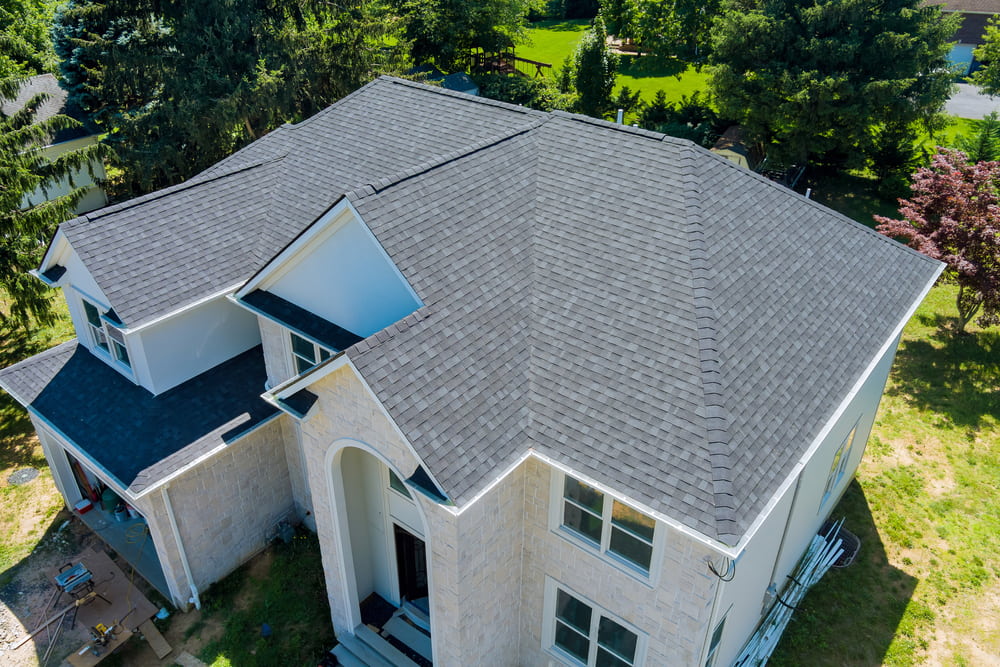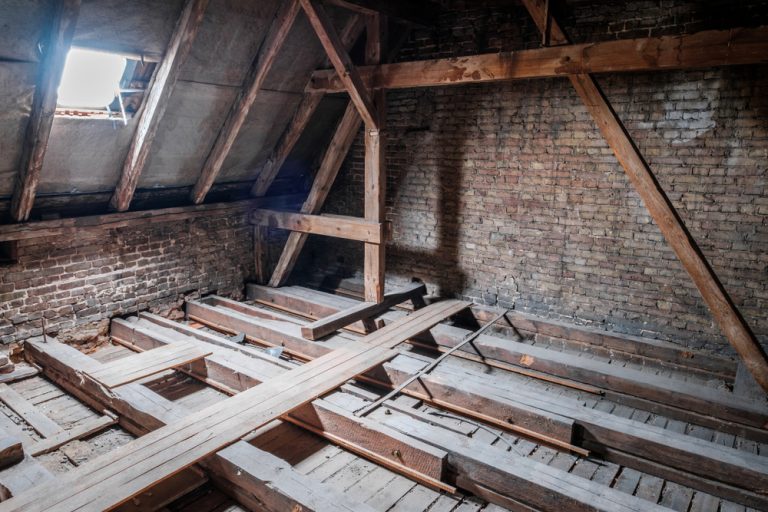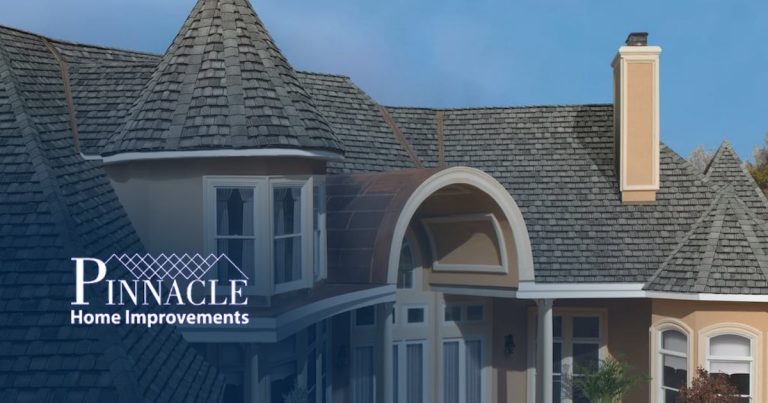Drive through any neighborhood and you’re bound to spot different types of roofs. The materials used provide homeowners with a variety of choices for making their homes unique, beautiful, and fortifying their structural integrity.
When it’s time for a roof replacement or new roof installation, choosing the correct roofing material is crucial for homeowners and builders alike. It has a major impact on a home’s longevity, energy efficiency, and aesthetic appeal, as well as on maintenance requirements and costs. With a vast array of options on the market, each type of roofing material offers distinct advantages and challenges, catering to different climatic conditions, budgets, and architectural styles.
Roofing materials all vary widely in terms of their durability, the weight they add to the structure, and installation methods. Some of the most common choices include asphalt shingles, which are prized for their cost-effectiveness and ease of installation, not to mention a plentiful selection of colors and styles.
Metal roofing is another option that’s quickly growing in popularity for residential properties, known for its durability and resistance to extreme weather. Slate and tile roofs provide a classic and distinguished appearance and a lifespan that can potentially exceed a century, though they typically come with higher costs and additional structural requirements due to their heavier weight.
Pinnacle Home Improvements is a top local roofing company focused on providing unparalleled craftsmanship and excellence in customer care. We understand that the properties of various roofing materials must be a decision that balances appearance, budget, performance, and sustainability.
It allows homeowners and construction professionals to select materials that not only protect against the elements but also complement the home’s architecture while adhering to cost constraints and local building codes. In this guide, we provide information to educate and inform you about roofing materials, allowing you to help you make the best selection for your home.
Considerations for Choosing Roofing Materials
When you’re trying to decide on roofing material for your roof replacement, you must evaluate several important factors. These include durability, aesthetics, cost, and energy efficiency, though it’s also best to think long-term and not just about the upfront cost of investing in your home.
Primary Factors to Consider When Choosing Roofing Materials
Let’s explore a bit more deeply into the main factors that must be considered when deciding on which roofing materials to use:
Durability
All roofing materials will have a lifespan, and some of them will last longer and provide greater resistance to the elements. Asphalt shingles are one of the most popular roofing materials, though they’ll last 15 to 30 years, depending on the type.
Metal roofing can last for 50 years or longer, which may make it a better choice if you live in a location with extreme weather. All told, you should think about your local climate and which material will provide you with the best longevity.
Cost
Of course, budget is going to be an important consideration for you when you look into having your roof replaced. You’ll quickly see that asphalt shingles are cost-effective in terms of the initial costs, while a premium material like slate will cost more. However, you shouldn’t just focus on the upfront costs of installation of these materials.
You should also consider the long-term value it’ll add as well as how much will be required for maintaining that particular material over the years. If you’re planning to move soon, you may only want to invest the bare minimum, though if you plan on living in this home until you’re old and gray years into the future, it may be a better idea to invest in a more expensive material that will require less maintenance and help you recoup your costs.
Appearance
The architecture of your home will also play a role in the roofing materials you choose. You’ll want it to have a cohesive look that adds to its curb appeal.
Energy Efficiency
Some roofing materials are more adept at helping your home become more energy efficient. Metal roofing, for example, is an excellent material that can help you reduce your cooling costs in the summer. You’ll be able to save more money while reducing your environmental impact.
Types of Roofing Materials
Now that you have an idea of what you should be considering as you choose roofing materials, it’s time to review your options. Roofing materials come in a variety of types, and within those types, there are different grades that all have specific features, benefits, and aesthetic appeal.
Take a look at some of the most common types of roofing materials you may be able to choose from when getting ready to install a new roof on your home:
1. Asphalt Shingles
Asphalt shingles are by far one of the most popular roofing material choices for homes in the U.S. This material is cost-effective, and since it’s easier to install, it keeps labor costs down. There are tons of colors and styles, and they can be upgraded to provide greater protection and longevity.
2. Metal Roofing
Metal roofs aren’t just for commercial properties and have surged in popularity for homes. Metal roofs are a solid choice since they’re incredibly durable, often made from steel, aluminum, copper, or zinc, and they can last for half a century or more. They can also be styled to look like other materials, giving you the look you want for your home while providing better protection in extreme weather.
3. Wood Shake
Wood shingles or shakes are prized for their natural look. Cedar and redwood are among the most popular, and they provide excellent insulation. On the downside, you’ll need to work harder to maintain roofs made of wood materials, and if you live in an area prone to wildfires, they may put you at risk unless you have them treated with fire-resistant coatings.
4. Slate Roofing
Slate is such an elegant roofing material, though it’s typically best for large estates and regal homes. It has a long lifespan that can go beyond that of metal, though it’s heavy and will require you to have a reinforced roof structure. It’s also fireproof and resistant to mold and fungus.
5. Tile Roofing
Roofing tiles are made from clay or concrete and are non-combustible. They come in many colors and shapes, and are often the best choice to complement Mediterranean architecture. However, these tiles are also heavy, which means you may have to add additional structural support.
6. Composite Roofing
Composite roofing is made from synthetic materials that imitate the look of much more expensive materials such as wood, tile, or slate. These are lighterand much easier to install, plus they require less maintenance. If you have your heart set on a slate roof but the cost is out of reach, composite roofing materials may offer the ideal solution.
7. Rubber Roofing
Rubber roofing is predominantly used on flat roofs or roofs with a low slope. Materials such as EPDM (ethylene propylene diene terpolymer) are used to provide a waterproof, lightweight, and environmentally friendly roofing structure.
For all roofing materials, you must carefully consider your climate, aesthetic, and other properties of your roof structure. Still not sure which roofing material to choose? Keep reading, and contact Pinnacle Home Improvements at any time to learn more.
Comparative Analysis of Roofing Materials
When trying to determine the best roofing material for your home, it’s important to look at how each option stands up in certain areas. All will have their own advantages and disadvantages, and understanding how those could impact you is the key to finding the right fit in terms of durability, budget, energy efficiency, and other factors.
Advantages and Disadvantages
There isn’t a completely perfect roofing material out there. Asphalt shingles are one of the most popular materials because they’re affordable, though they have a shorter lifespan, which means that you’ll need to replace them eventually point if you’re staying in your home forever.
Metal roofs are more durable and fire resistant, though they initially cost more. Slate is beautiful and lasts longer than a lifetime, though it’s heavy and needs added reinforcement for the roof structure, plus it’s expensive.
Take a deeper look at the factors that can bring benefits and drawbacks for the various roofing materials you may choose for your home:
Durability and Maintenance
Asphalt Shingles
Starting with asphalt shingles, this popular roofing choice tends to last 15 to 30 years, depending on the type. The most basic options will be on the lower end of that lifespan, while premium options will last longer. Maintenance is fairly straightforward, though these shingles can be impacted by wind uplif,t and they’re less resistant to extreme temperatures.
- Pros: Affordable, easy to repair, and available in many colors and styles
- Cons: Short lifespan and more vulnerable to the weather
Metal Roofing
Metal Roofing offers exceptional durability and can potentially last 40 to 70 years. It also requires minimal maintenance while having strong resistance to fire, wind, and impact. If you’re looking for a roof that will last, metal is a superb choice. However, it costs more upfront.
- Pros: Durable and long lifespan, capable of resisting extreme weather
- Cons: Higher upfront cost, and the need for reputable professional installation is critical
Slate Tiles
Slate is one of the longest-lasting options, potentially lasting over 100 years. It’s fire and decay-resistant, though it’s a pricey material, made even more expensive by complex installation.
- Pros: Slate is gorgeous, providing a natural stone look, and lasts the longest
- Cons: This material is heavy, requires additional reinforcement, and is challenging to install, not to mention expensive
Concrete Tiles
Concrete tiles are durable and can last 50 years or longer, though their weight is something to consider since it requires reinforcing the roof structure. This material is resistant to fire and rot and can easily beautify your home, though it’s important to determine if it matches your architectural aesthetic, too.
- Pros: Beautiful and available in many styles, plus fire and rot resistan,t with a great lifespan
- Cons: Weighs more, which may require added structural support
Cost-Effectiveness
When it comes to the costs, they certainly need to be a factor in your decision, though they shouldn’t be your only consideration. Asphalt shingles are most commonly chosen because they’re budget-friendly.
They tend to cost around $1.50 to $5.50 on average per square foot. If you want to balance affordability and performance, asphalt shingles are an economical solution when you need to replace your roof. However, do keep in mind that while cheaper initially, you’ll need to factor in maintenance as well as future roof replacements if you plan to stay in your home for many years to come.
As for metal roofing, it’s more costly at $6 to $12 per square foot, though the long-term savings shouldn’t be ignored. They last much longer and require very minimal maintenance, and this may be a better option if you’re planning to live in your property for decades ahead.
Slate is a premium choice, with prices ranging from $9 to $20 per square foot. The initial costs are incredibly high, though it offers greater longevity. If you have the budget to allow for slate, it’s certainly worth exploring.
Concrete tiles tend to cost between $4 and $10 per square foot. They’re cost-effective yet durable without such a high price tag as slate.
At a glance:
- Asphalt shingles have the lowest initial cost with moderate long-term costs.
- Metal roofing has a high initial cost with a low long-term cost
- Slate has a very high initial cost and low costs over the long term
- Concrete tiles are moderately priced initially, while having low long-term costs
As you can see, it isn’t just about the initial costs when you look at the materials for your roof. You should also be thinking of how much it will cost you over the long term to help you make the best decision.
Energy Efficiency
Another area that can impact your long-term costs is energy efficiency, and it helps to see how these common roofing materials for homes can help you.
Asphalt Shingles
Asphalt shingles aren’t the most insulated solution, and in colors, they absorb more heat, which can cause your cooling expenses to rise, particularly in warmer climates.
However, they can be treated with reflective coatings, or you can choose them in lighter hues to combat this issue. Another concern with these shingles is that the basic options have poor reflective properties. Again, if you choose architectural shingles, for example, you’ll have a more premium material that can reflect heat away from your home.
Metal Roofing
Metal roofs reflect solar radiant heat, and this can translate to 10 to 25% reductions in your cooling costs. It’s also important to consider that the insulation for this material must be done right to help improve its performance, particularly in cooler climates.
Slate Tiles
The natural density of slate is a prime insulator for homes, which will contribute to your energy savings. On the downside, its thermal mass can hold onto heat, which can impact energy consumption in certain climates.
Concrete Tiles
Concrete tiles are known for having inherent thermal mass, providing you with big energy benefits. This material allows you to keep your home cooler in summer while keeping you warm in winter.
Top Roofing Material Picks for Different Needs
When choosing the right roofing material for your home, it will come down to your local climate, home style, and budget. You’ll need to prioritize your needs to help you find the best fit.
If your biggest concern is high durability, then you should choose metal roofing or slate tiles. For the most aesthetic variety and options for appearance, you may want to go with asphalt shingles as they come in many colors, styles, and shapes. Clay tiles can also be a great option to enhance the curb appeal of your home.
When budget is your biggest concern, rolled roofing is an economical option that can quickly fix roofs with low inclines, though a better option is asphalt shingles. These are both cost-effective and easy to install, plus they also look good.
Climate should also be part of your decision, and if you live in an area that gets lots of snowfall, you’ll want a sloped roof that promotes easy snow shedding. Metal is excellent for this, making it easier to have peace of mind in frigid locations. As for those in areas prone to wildfire, look at materials that provide fire resistance, like clay or slate.
Get Professional Guidance from Pinnacle Home Improvements
When choosing the most appropriate roofing material for your home, you should speak with a licensed roofing professional who can give you valuable insights into the pros and cons of each option. They can assess the needs of your property and offer advice for the climate and your structure.
Schedule a consultation, and we’ll help you look at:
- Durability and how these materials vary in lifespan, as well as protection from the elements
- Cost for the initial outlay, as well as long-term maintenance needs
- Appearance options that can providea cohesive style and align with the architecture
- Weight of the materials and whether structural support must be added
- Maintenance costs over the long term
Our professionals will ensure that you make an informed choice by considering factors such as energy efficiency, sustainability, and local building codes. They’re up-to-date with the latest innovations in roofing technologies and can help guide you to the materials with the best performance and value for their situation.
Maintenance Tips for Your New Roof
Doing proper maintenance is key to extending the lifespan of a roof, regardless of the material used. For asphalt shingles, you’ll want to clean them regularly and quickly replace any damaged shingles to prevent serious damage.
On metal roofing, you’ll need to have regular inspections conducted to check for dents and apply a rust-resistant coating to protect it. Paint touch-ups may also be needed to keep it looking its best. For slate, you must keep these tiles free of debris. Although strong, these tiles can break, and when they do, you must get them fixed quickly. Clay tiles should also be replaced when they crack, and the underlayment needs to be maintained to prevent leaks.
No matter which roofing material you’ve selected, gutter maintenance is imperative. This ensures water is guided away from the roof, preventing serious damage. You’ll also want a professional to conduct a check of the underlayment every few years to help you prolong your roof’s lifespan and avoid costly problems.
Don’t forget to also pay attention to insulation and ventilation, as these areas are part of a well-functioning roof. If you notice your attic insulation isn’t performing or spot signs of moisture, call a professional right away to help get things back on track.
Contact Us for Roof Installation
At Pinnacle Home Improvements, we’re renowned for our expertise in roofing materials and installation. We provide an extensive array of services that can meet your needs, such as roofing solutions that range from traditional shingles to more modern and environmentally-friendly options.
As a leader in the industry, we stand out for our commitment to quality, customer satisfaction, and cutting-edge roofing technology. Our team is equipped to guide you through the material selection process, ensuring an informed decision for your roofing project.
When it comes to protecting your home from the elements, your roof plays a pivotal role. Whether you’re facing the unflinching sun, heavy rain, or the occasional hailstorm, your roof is your home’s first line of defense. That’s why it’s so crucial to choose the right partner for your roofing needs.
Pinnacle Home Improvements stands out as the go-to expert for roof installation and replacement. Our commitment to quality craftsmanship and customer satisfaction means you can trust us to handle your roofing project with the utmost care and professionalism. Contact us today to get a free quote on our roofing services.














